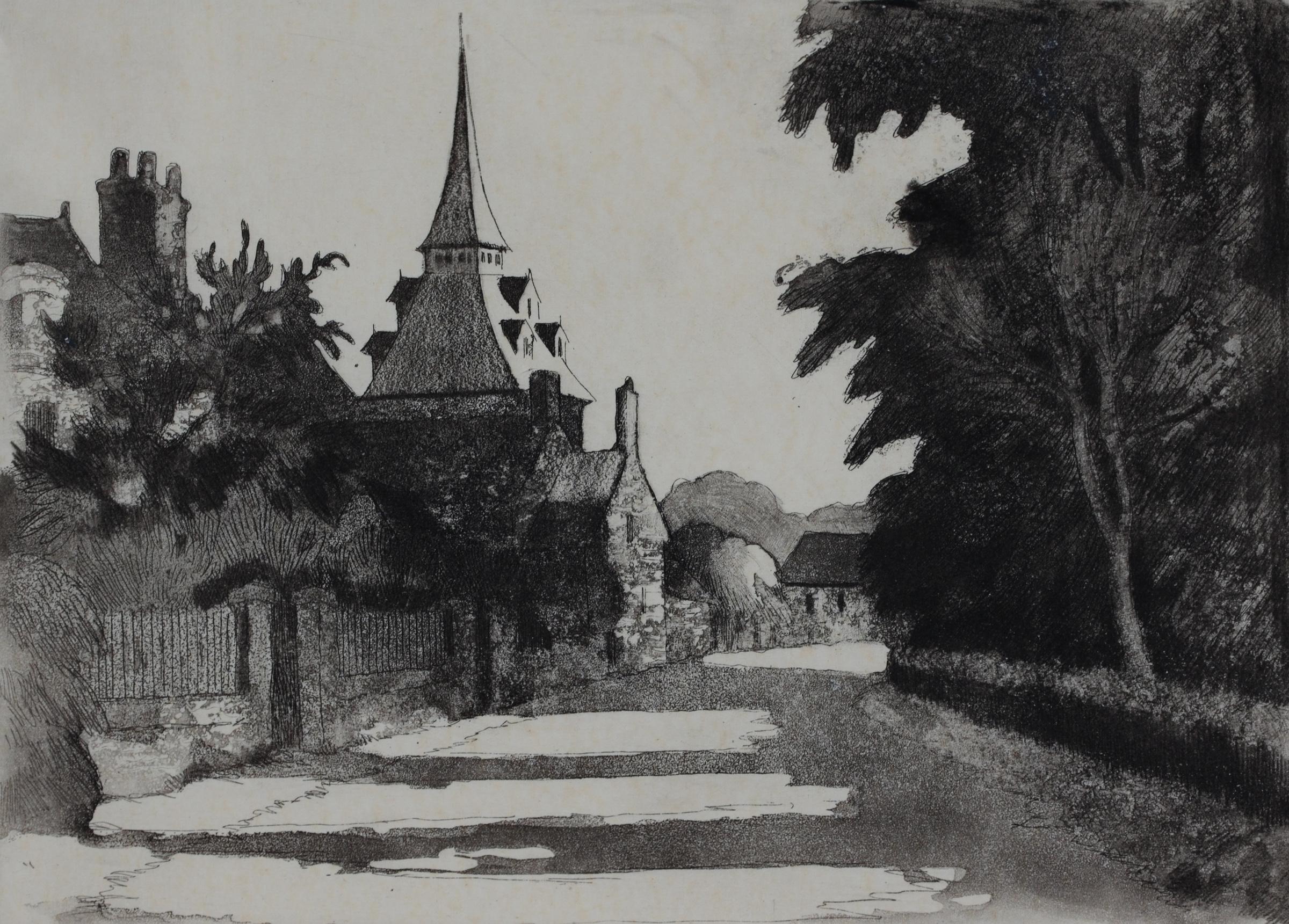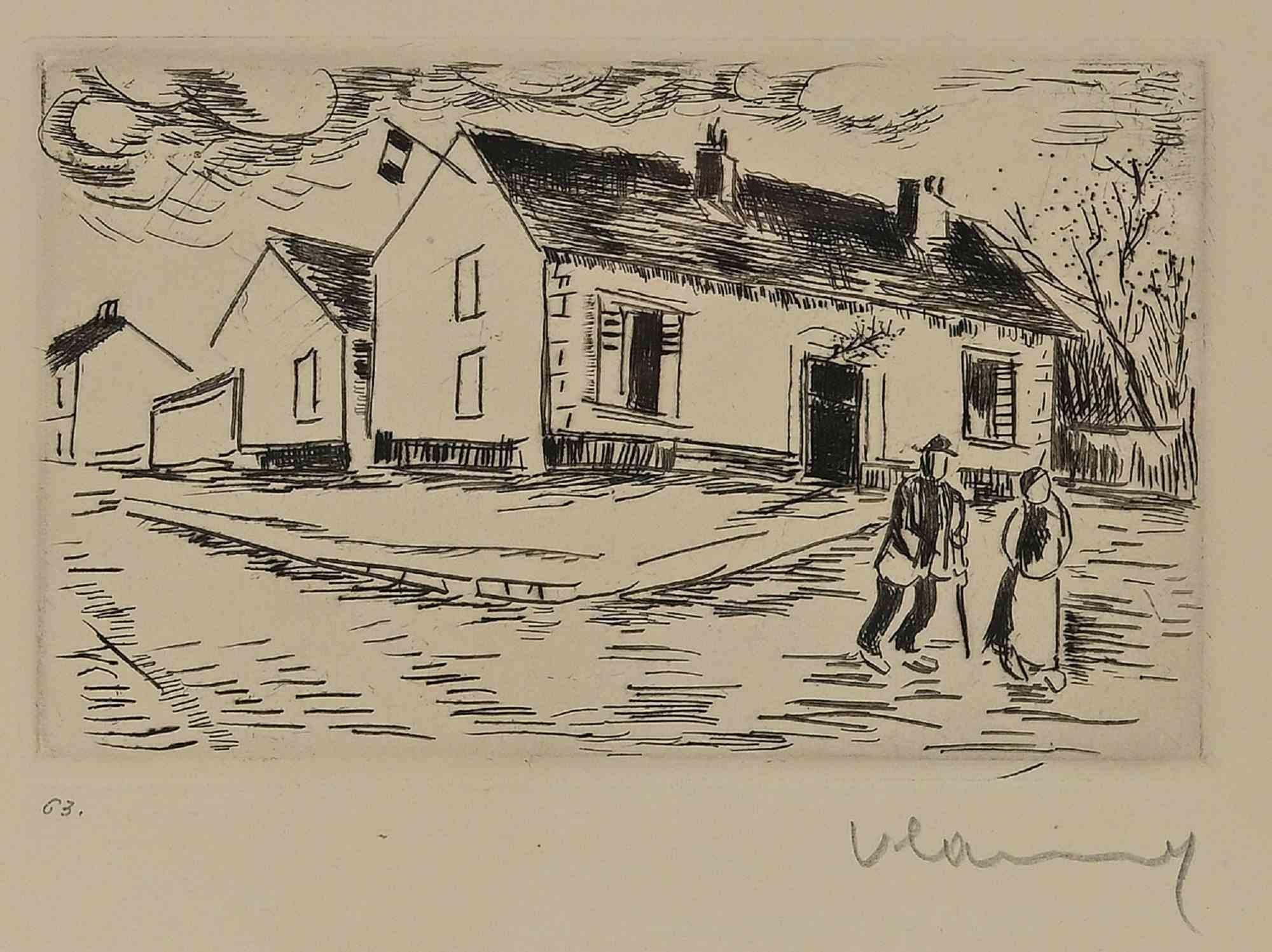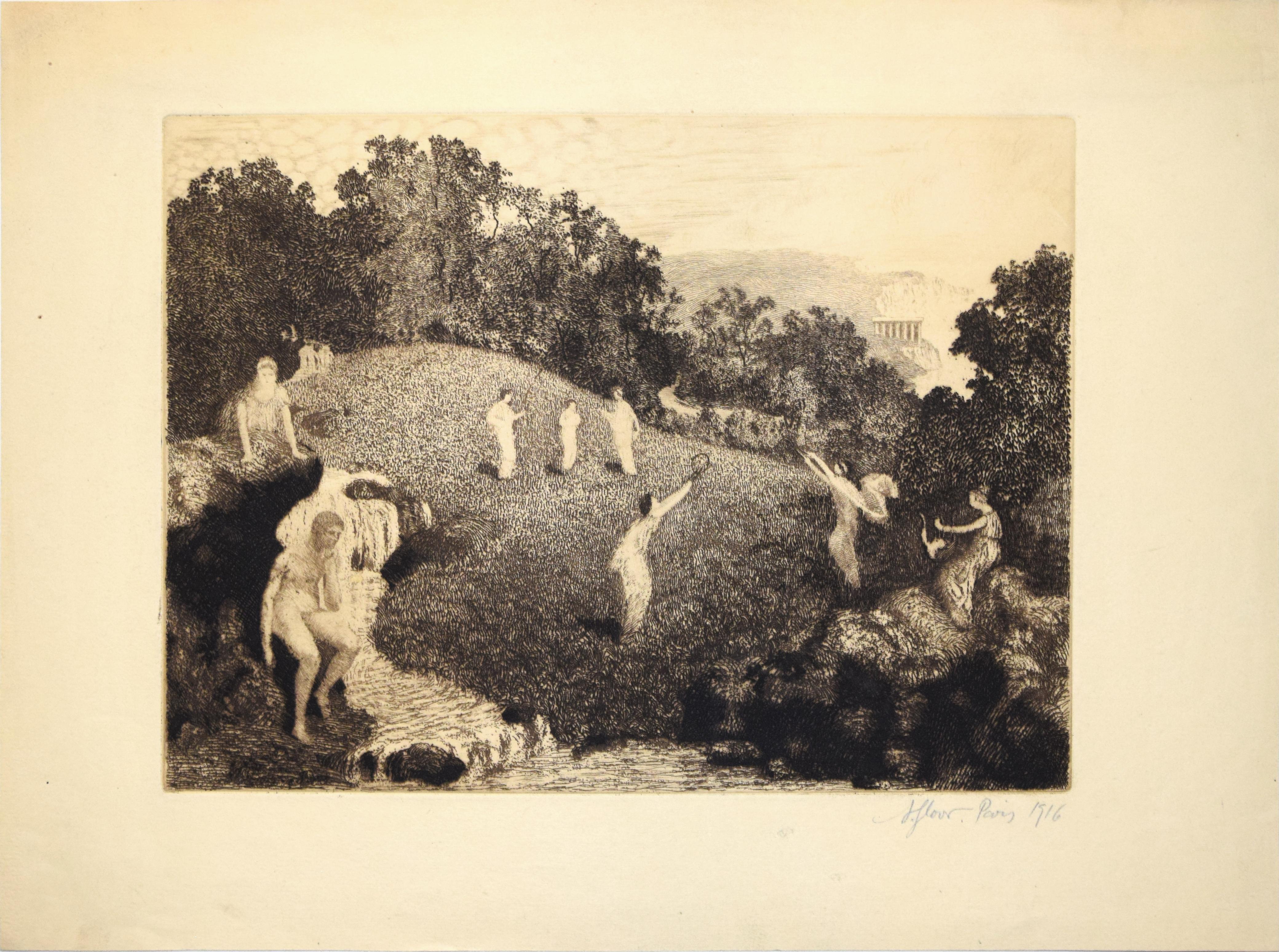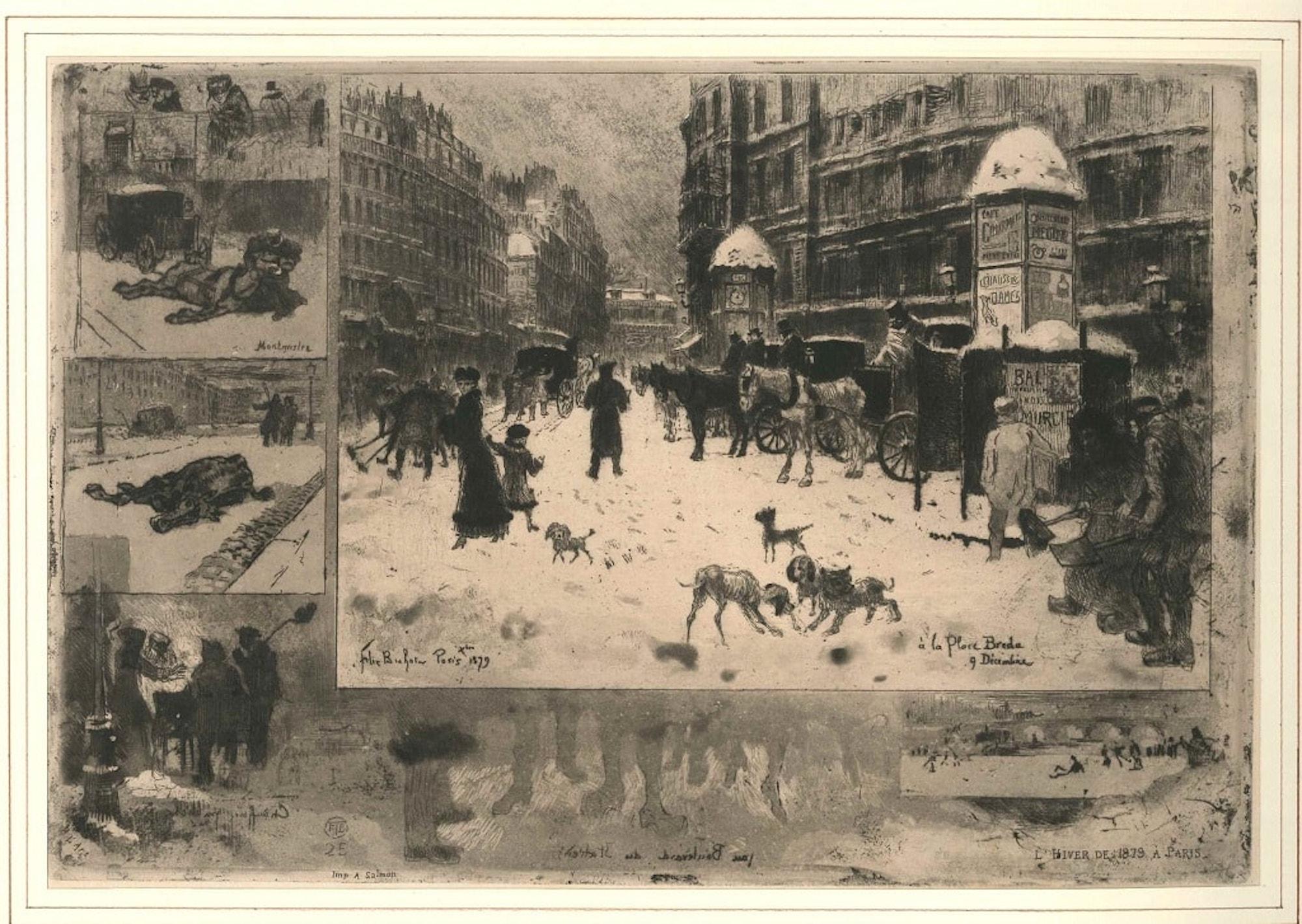Items Similar to Arch of the Pont Neuf, Paris
Want more images or videos?
Request additional images or videos from the seller
1 of 9
Sir Frank BrangwynArch of the Pont Neuf, Paris1923
1923
About the Item
Arch of the Pont Neuf, Paris
Etching on heavy wove paper, 1923
Signed in pencil lower right (see photo)
From: Brangwyn Portfolio (12 original etchings and three lithographs)
Published by E. F. D'Aligan and Paul Turpin, Editeurs, Paris
Edition: 120 (80/120) on title page
Original price: 100 guineas
Reference: Gaunt 282, published edition
Image/plate size: 21 7/8 x 13 3/8 inches
Sheet size: 23 15/16 x 17 5/8 inches
Condition: Excellent
- Creator:Sir Frank Brangwyn (1867-1956, British)
- Creation Year:1923
- Dimensions:Height: 21.875 in (55.57 cm)Width: 13.375 in (33.98 cm)
- Medium:
- Movement & Style:
- Period:
- Condition:
- Gallery Location:Fairlawn, OH
- Reference Number:
About the Seller
5.0
Recognized Seller
These prestigious sellers are industry leaders and represent the highest echelon for item quality and design.
Platinum Seller
These expertly vetted sellers are 1stDibs' most experienced sellers and are rated highest by our customers.
Established in 1978
1stDibs seller since 2013
716 sales on 1stDibs
Typical response time: 1 hour
Associations
International Fine Print Dealers Association
- ShippingRetrieving quote...Ships From: Fairlawn, OH
- Return PolicyA return for this item may be initiated within 10 days of delivery.
More From This SellerView All
- Saint TropezBy André Dunoyer de SegonzacLocated in Fairlawn, OHSaint Tropez Etching with aquatint, printed in colors, 1964 Signed in ink and numbered in pencil Edition: 71/100 Issued for the album St. Tropez et la Provence, in 1966 Reference: Lo...Category
1960s Post-Impressionist Landscape Prints
MaterialsEtching
- BougivalBy Maurice de VlaminckLocated in Fairlawn, OHBougival Woodcut, 1914 Signed and numbered in pencil Edition 30, this numberd 22 Printed on laid Van Gelder Zonen paper Published by Henri Kanweiler, Paris Printed by Paul Birault, Paris Bougival is located west of Paris, on the left bank of the River Seine. This woodcut was inspired by Vlaminck's 1905 Fauvist masterpiece of the same title in the collection of the Detroit Institute of Art. An impression of this image is in the Yale Univeristy Art Gallery, Condition: Very slight sun staining, otherrwise very good Image/block size: 13 1/4 x 16 1/4 inches Sheet size: 19 1/8 x 22 1/8 inches Reference: Walterskirchen 11b Maurice de Vlaminck (4 April 1876 – 11 October 1958) was a French painter. Along with André Derain and Henri Matisse, he is considered one of the principal figures in the Fauve movement, a group of modern artists who from 1904 to 1908 were united in their use of intense colour.] Vlaminck was one of the Fauves at the controversial Salon d'Automne exhibition of 1905. Life Maurice de Vlaminck was born on Rue Pierre Lescot in Paris. His father Edmond Julien was Flemish and taught violin and his mother Joséphine Caroline Grillet came from Lorraine and taught piano His father taught him to play the violin.[3] He began painting in his late teens. In 1893, he studied with a painter named Henri Rigalon on the Île de Chatou In 1894 he married Suzanne Berly. The turning point in his life was a chance meeting on the train to Paris towards the end of his stint in the army. Vlaminck, then 23 and already active in anarchist circles in Paris, met an aspiring artist, André Derain, with whom he struck up a lifelong friendship.] When Vlaminck completed his army service in 1900, the two rented a studio together, the Maison Levanneur, which now houses the Cneai,[6] for a year before Derain left to do his own military service. In 1902 and 1903 he wrote several mildly pornographic novels illustrated by Derain. He painted during the day and earned his livelihood by giving violin lessons and performing with musical bands at night. Vlaminck participated in the controversial 1905 Salon d'Automne exhibition. After viewing the boldly colored canvases of Vlaminck, Henri Matisse, André Derain, Albert Marquet, Kees van Dongen, Charles Camoin, and Jean Puy, the art critic Louis Vauxcelles disparaged the painters as "fauves" (wild beasts), thus giving their movement the name by which it became known, Fauvism. In 1911, Vlaminck traveled to London and painted by the Thames. In 1913, he painted again with Derain in Marseille and Martigues. In World War I he was stationed in Paris, and began writing poetry. Eventually he settled in Rueil-la-Gadelière, a small village south-west of Paris. He married his second wife, Berthe Combes, with whom he had two daughters. From 1925 he traveled throughout France, but continued to paint primarily along the Seine, near Paris. Resentful that Fauvism had been overtaken by Cubism as an art movement Vlaminck blamed Picasso "for dragging French painting into a wretched dead end and state of confusion". During the Second World War, Vlaminck visited Germany and on his return published a tirade against Picasso and Cubism in the periodical Comoedia in June 1942. Vlaminck wrote many autobiographies. Vlaminck died in Rueil-la-Gadelière on 11 October 1958. Artistic career Two of Vlaminck's groundbreaking paintings, Sur le zinc (At the Bar) and L'homme a la pipe (Man Smoking a Pipe) were painted in 1900. For the next few years Vlaminck lived in or near Chatou (the inspiration for his painting houses at Chatou), painting and exhibiting alongside Derain, Matisse, and other Fauvist painters. At this time his exuberant paint application and vibrant use of colour displayed the influence of Vincent van Gogh. Sur le zinc called to mind the work of Toulouse-Lautrec and his portrayals of prostitutes and solitary drinkers, but does not attempt to probe the sitter's psychology—a break with the century-old European tradition of individualized portraiture. According to art critic Souren Melikian, it is "the impersonal cartoon of a type. In his landscape paintings, his approach was similar. He ignored the details, with the landscape becoming a vehicle through which he could express mood through violent colour and brushwork. An example is Sous bois, painted in 1904. The following year, he began to experiment with "deconstruction," turning the physical world into dabs and streaks of colour that convey a sense of motion. His paintings Le Pont de Chatou (The Chatou Bridge), Les Ramasseurs de pommes de terre (The Potato Pickers...Category
1910s Fauvist Landscape Prints
MaterialsWoodcut
- Saint-Tropez-Le PortBy Paul SignacLocated in Fairlawn, OHSaint-Tropez-Le Port Color lithograph, 1897-1898 Signed in pencil lower right (see photo) Numbered in pencil lower right: No. 68 (see photo) From: Album des Peintres-Gravures, 1898 Published by Ambrose Vollard, Paris Printer: Auguste Clot, Paris Edition: 100 Numbered: No. 68 Reference: Una Johnson, Vollard, No. 188, reproduced pale 35 Kornfeld & Wick, No. 19 b/b Condition: Very fresh colors One tiny spot in the upper margin above the image (see photo) Image size: 17 1/8 x 13 inches Frame size: 32 3/4 x 27 1/4 inches Archival framing by Galerie Maximilian, Aspen, CO Museum glass 22K Gold leaf hand carved frame...Category
1890s Post-Impressionist Landscape Prints
MaterialsLithograph
- Minneapolis at DuskBy Richard HaasLocated in Fairlawn, OHMinneapolis at Dusk Etching & aquatint printed in colors, 1993 Signed, titled and numbered in pencil Edition: 65 (19/65) Condition: Excellent This image depicts the Wells Fargo Center designed by Cesar Pelli Richard Haas (American, b.1936) is a practitioner of the trompe l'oeil artistic style, a technique that uses realistic images in a way that tricks the eye into perceiving the painting in three dimensions. Haas has painted hundreds of murals that incorporate trompe l'oeil methods in the depiction of the architectural features of the building. He was born in Spring Greene but grew up in Milwaukee, WI. He graduated in 1959 from the University of Wisconsin-Milwaukee with a Bachelor in Art. Instructors for his courses included Joseph Friebert (American, 1908–2002) and Robert Von Neuman (German, 1888–1976). Haas returned to his birthplace to work as a helper for his stonemason uncle, and he had an opportunity to view the work of the architect Frank Lloyd Wright (American, 1867–1959). He spent several years as an assistant professor at the University of Michigan before he moved to New York City in 1968. Haas spent 10 years teaching at Vermont's Bennington College, splitting his time between the school and New York. Haas worked for many years as an Abstract painter who used traditional canvas media. He later developed an interest in drawing and etching the details of late 19th century and early 20th century New York City buildings. The artist’s first outdoor mural, a commission to paint the cast iron façade at the corner of Prince Street and Greene Street, was completed in 1975. His other notable murals include Fort Worth, Texas' Homage to Chisholm Trail...Category
1990s Photorealist Landscape Prints
MaterialsEtching
- La Grande Cascade de Saint CloudBy Alfredo MüllerLocated in Fairlawn, OHLa Grande Cascade de Saint Cloud Color aquatint on watermarked Arches J Perrigot paper, 1905 Signed by the artist in pencil lower right. (see photo) Edition: 100. Numbered "39" in pencil lower left. Titled in pencil verso Published by Edmund Sagot, Paris, his dry stamp lower right below signature. Image: 23-1/8 x 17-3/8" (58.7 x 44 cm.) From the British Museum: "Colour etcher. Born in Livorno from a family of wealthy Swiss cotton merchants, studied with Giuseppe Ciaranfi and Michele Gordigiani in Florence. In 1886 exhibited with Fattori, Achille Lega and Tommasi in the Prima Esposizione delle Belle Arti in Livorno. In 1888 he and his family moved to Paris, where he studied first with François Flameng until 1892 and later with Carolus-Duran. Müller remained in the French capital until the outbreak of the First World War, taking French citizenship in 1913. He worked in the countryside at Barbizon, Suresnes and elsewhere, but also made frequent visits to his native country, where he exhibited regularly in Florence with the Promotrice Fiorentine. His early work was indebted to Fattori and Plinio Nomellini, but he soon became interested in the Impressionists and was credited by the critic Mario Tinti with introducing the luminism of Monet into Italian art. Müller was a member of the Société des Artistes Indépendents and exhibited regularly in the Paris dealer George Petit's annual exhibitions of colour prints. He made his first print in 1896, a lithographic portrait of the poet Paul Verlaine in the Café Procope. The following year Müller made his first colour aquatints. Among them were a series of illustrations to Dante's Divine Comedy. In style his etchings and aquatints were influenced by Manuel Robbe. Very occasionally he combined drypoint or soft ground etching with aquatint. Müller's principal publisher was Pierrefort, who also issued prints by Toulouse-Lautrec. After 1903 he largely abandoned aquatint for pure etching. Fourteen of his colour etchings were reproduced over a number of months in the weekly magazine 'Le Courrier français'. Müller also made a small number of colour lithographs, some of which were published by the Parisian print dealer Sagot. A single monotype of Mallarmé done in 1911, thirteen years after the poet's death in 1898, is recorded. Müller made a few landscape prints and a couple of etchings of fishing boats, but his principal subject was young women in long dresses. Often there is an aura of fin-de-siècle wistfulness. When he returned to Italy, he lived first in Taormina, then in Florence, and finally settled in a villa at Settignano. Müller largely abandoned printmaking after 1914. Only three more prints by him made in 1920, 1925 and 1933 are recorded after he moved back to his native country. Müller was a regular exhibitor in Florentine exhibitions, the most significant of which was the 1922 Primaverile Fiorentina. He returned to France in 1930 where he died in 1939. (Text by Martin Hopkinson)" Said to rival the fountains at Versailles, La Grande Cascade is still turned on for a few hours every Sunday in June. The Grande Cascade, constructed in 1664-1665 by Antoine Le Pautre has survived. The château was expanded by Phillipe de France, duc d'Orléans in the 17th century, and finally enlarged by Marie Antoinette in the 1780s. Napoleon I and Napoleon III also used the palace, which was a U-shaped scheme of three sections, open to the east. Destroyed by fire (with the exception of a few outbuildings and its majestic garden) in 1870, during the Franco-Prussian War. The burned-out shell stood until 1891, when it was demolished. The gardens were replanned by André Le Nôtre...Category
Early 1900s French School Prints and Multiples
MaterialsAquatint
- Desolation, S.C. or Deserted Cabins, Beauford, S.C.By Louis Oscar GriffithLocated in Fairlawn, OHDesolation, S.C. or Deserted Cabins, Beauford, S.C. Etching & Aquatint, c. 1930 Signed by the artist in pencil lower right (see photo) Annotated "Trial Proof" in pencil lower left co...Category
1930s American Impressionist Landscape Prints
MaterialsAquatint
You May Also Like
- Le Village de Landel by Paulémile Pissarro - etchingLocated in London, GBSOLD UNFRAMED Le Village de Landel by Paulémile Pissarro (1884 - 1972) Etching 17.2 x 23.7 cm (6 ¾ x 9 ⅜ inches) Signed lower right, Paulémile-Pissarro and numbered lower left, 2e e...Category
20th Century Post-Impressionist Landscape Prints
MaterialsEtching
- Village - Etching by M. de Vlaminck - 1950By Maurice de VlaminckLocated in Roma, ITVillage is a modern artwork realized by Maurice de Vlaminck in 1950. Black and white etching. Hand signed and dated on the lower margin. Edition of 100 specimen as reported on th...Category
1950s Post-Impressionist Landscape Prints
MaterialsEtching
- Cowdray Castle (with cows)By Sir Francis Seymour Haden, R.A.Located in Roma, ITBeautiful proof on verge, with note “Pl.194” and signed by the artist in pencil. Full margins. Ex-coll. H.H. Benedict (Lugt 1298), with dry stamp not identified. Ref. Cat. Harrington...Category
1880s Post-Impressionist Landscape Prints
MaterialsDrypoint, Etching
- Group of three Clowns - Etching and Drypoint by Jean Lurçat - 1921By Jean LurçatLocated in Roma, ITHand Signed and signed on plate. Edition of 35 prints. Image Dimensions : 30 x 20 cm This artwork is shipped from Italy. Under existing legislation, any artwork in Italy created ove...Category
1920s Post-Impressionist Landscape Prints
MaterialsDrypoint, Etching
- Figures in the Landscape - Etching by J. A. Flour - 1916By Jules Adrian FlourLocated in Roma, ITFigures in the Landscape is an original artwork realized by Jules Adrian Flour in 1916. Original etching on paper. The artwork is glued on cardboard. Hand-signed in pencil by the ar...Category
1910s Post-Impressionist Figurative Prints
MaterialsEtching
- La neige à Paris (Snow in Paris) - Etching by F. H. Buhot - 1879By Félix Hilaire BuhotLocated in Roma, ITWonderful etching, aquatint, drypoint, and wheel on laid ivory colored paper. Signed inside out on plate on the lower margin at the center. Each image of the composition is hand-titled on the plate on lower margins. Fourth state on nine. Edition of the “L’Art. Excellent conditions, including ivory colored cardboard passe-partout (cm 33.5 x 49). The print has been given the titles of “L’Hiver à Paris “ or “ La Neige à Paris”. The modern artwork represents the rigorous winter of 1879 with Arctic temperatures and vast quantities of snow covered the Parisian streets. Reference: B.G. I28 The present print, one of his best known, exemplifies these preoccupations. The published version appeared in the journal L'Art (n° 314) in January 1881. As Bourcard clearly states "There were numerous trial proofs pulled and an extraordinary variety of printings in the various impressions of this plate. There exist a few rare artist's proofs of the state before the words: L'Art, the number 25, L'Hiver de 1879 à Paris." Félix Hilaire Buhot...Category
1870s Post-Impressionist Figurative Prints
MaterialsEtching, Aquatint





